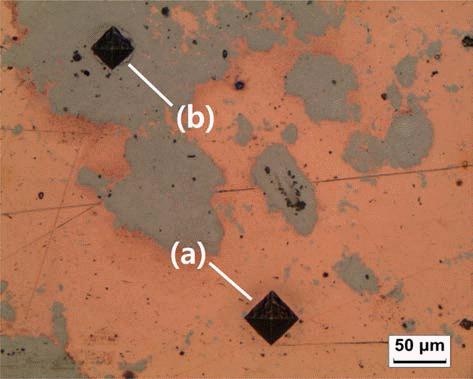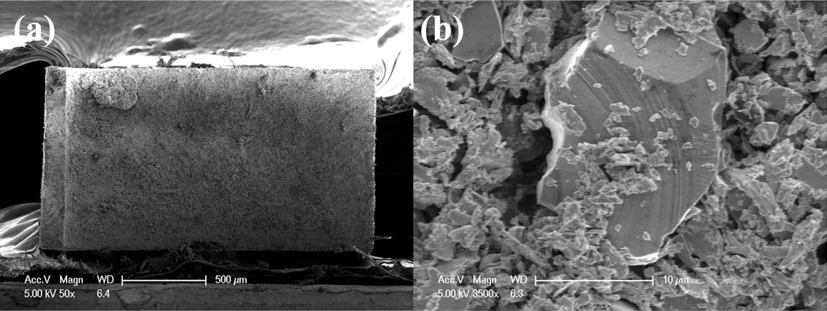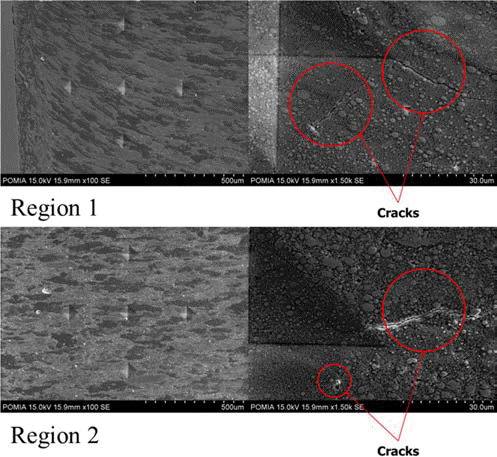Search
- Page Path
- HOME > Search
- [Korean]
- Analysis of the Change in Microstructures of Nano Copper Powders During the Hydrogen Reduction using X-ray Diffraction Patterns and Transmission Electron Microscope, and the Mechanical Property of Compacted Powders
- Dong-Hyun Ahn, Dong Jun Lee, Wooyeol Kim, Lee Ju Park, Hyoung Seop Kim
- J Korean Powder Metall Inst. 2014;21(3):207-214. Published online June 1, 2014
- DOI: https://doi.org/10.4150/KPMI.2014.21.3.207

- 491 View
- 0 Download
-
 Abstract
Abstract
 PDF
PDF In this study, nano-scale copper powders were reduction treated in a hydrogen atmosphere at the relatively high temperature of 350°C in order to eliminate surface oxide layers, which are the main obstacles for fabricating a nano/ultrafine grained bulk parts from the nano-scale powders. The changes in composition and microstructure before and after the hydrogen reduction treatment were evaluated by analyzing X-ray diffraction (XRD) line profile patterns using the convolutional multiple whole profile (CMWP) procedure. In order to confirm the result from the XRD line profile analysis, transmitted electron microscope observations were performed on the specimen of the hydrogen reduction treated powders fabricated using a focused ion beam process. A quasi-statically compacted specimen from the nanoscale powders was produced and Vickers micro-hardness was measured to verify the potential of the powders as the basis for a bulk nano/ultrafine grained material. Although the bonding between particles and the growth in size of the particles occurred, crystallites retained their nano-scale size evaluated using the XRD results. The hardness results demonstrate the usefulness of the powders for a nano/ultrafine grained material, once a good consolidation of powders is achieved.
- [Korean]
- Manufacturing and Evaluation of the Properties of Hybrid Bulk Material by Shock-compaction of Nanocrystalline Cu-Ni Mixed Powder
- Wooyeol Kim, Dong-Hyun Ahn, Lee Ju Park, Hyoung Seop Kim
- J Korean Powder Metall Inst. 2014;21(3):196-201. Published online June 1, 2014
- DOI: https://doi.org/10.4150/KPMI.2014.21.3.196

- 597 View
- 0 Download
-
 Abstract
Abstract
 PDF
PDF In this study, nanocrystalline Cu-Ni bulk materials with various compositions were cold compacted by a shock compaction method using a single-stage gas gun system. Since the oxide layers on powder surface disturbs bonding between powder particles during the shock compaction process, each nanopowder was hydrogen-reduced to remove the oxide layers. X-ray peak analysis shows that hydrogen reduction successfully removed the oxide layers from the nano powders. For the shock compaction process, mixed powder samples with various compositions were prepared using a roller mixer. After the shock compaction process, the density of specimens increased up to 95% of the relative density. Longitudinal cross-sections of the shock compacted specimen demonstrates that a boundary between two powders are clearly distinguished and agglomerated powder particles remained in the compacted bulk. Internal crack tended to decrease with an increase in volumetric ratio of nano Cu powders in compacted bulk, showing that nano Cu powders has a higher coherency than nano Ni powders. On the other hand, hardness results are dominated by volume fraction of the nano Ni powder. The crystalline size of the shock compacted bulk materials was greatly reduced from the initial powder crystalline size since the shock wave severely deformed the powders.
- [Korean]
- Manufacturing and Evaluation of Properties of Nanocrystalline Ni bulk by Dynamic Compaction of Nano Ni powders using a Gas-gun System
- Wooyeol Kim, Dong-Hyun Ahn, Lee Ju Park, Jong-Il Park, Hyoung Seop Kim
- J Korean Powder Metall Inst. 2014;21(1):44-49. Published online February 1, 2014
- DOI: https://doi.org/10.4150/KPMI.2014.21.1.44

- 512 View
- 0 Download
-
 Abstract
Abstract
 PDF
PDF In this study, nanocrystalline nickel powders were cold compacted by a dynamic compaction method using a single-stage gas gun system. A bending test was conducted to measure the bonding strengths of the compacted regions and microstructures of the specimen were analyzed using a scanning electron microscopy. The specimen was separated into two parts by a horizontal crack after compaction. Density test shows that the powder compaction occurred only in the upper part of the specimen. Brittle fracture was occurred during the bending test of the compact sample. Dispersion of shock energy due to spalling highly affected the bonding status of the nanocrystalline nickel powder.
- [Korean]
- Planar Shock Wave Compaction of Oxidized Copper Nano Powders using High Speed Collision and Its Mechanical Properties
- Dong-Hyun Ahn, Wooyeol Kim, Lee Ju Park, Hyoung Seop Kim
- J Korean Powder Metall Inst. 2014;21(1):39-43. Published online February 1, 2014
- DOI: https://doi.org/10.4150/KPMI.2014.21.1.39

- 679 View
- 1 Download
- 2 Citations
-
 Abstract
Abstract
 PDF
PDF Bulk nanostructured copper was fabricated by a shock compaction method using the planar shock wave generated by a single gas gun system. Nano sized powders, average diameter of 100 nm, were compacted into the capsule and target die, which were designed to eliminate the effect of undesired shock wave, and then impacted with an aluminum alloy target at 400 m/s. Microstructure and mechanical properties of the shock compact specimen were analyzed using an optical microscope (OM), scanning electron microscope (SEM), and micro indentation. Hardness results showed low values (approximately 45~80 Hv) similar or slightly higher than those of conventional coarse grained commercial purity copper. This result indicates the poor quality of bonding between particles. Images from OM and SEM also confirmed that no strong bonding was achieved between them due to the insufficient energy and surface oxygen layer of the powders.
-
Citations
Citations to this article as recorded by- Compressibility of hierarchic-architectured agglomerates of hydrogen-reduced copper nanopowders
Dong-Hyun Ahn, Wooyeol Kim, Eun Yoo Yoon, Hyoung Seop Kim
Journal of Materials Science.2016; 51(1): 82. CrossRef - Analysis of the Change in Microstructures of Nano Copper Powders During the Hydrogen Reduction using X-ray Diffraction Patterns and Transmission Electron Microscope, and the Mechanical Property of Compacted Powders
Dong-Hyun Ahn, Dong Jun Lee, Wooyeol Kim, Lee Ju Park, Hyoung Seop Kim
Journal of Korean Powder Metallurgy Institute.2014; 21(3): 207. CrossRef
- Compressibility of hierarchic-architectured agglomerates of hydrogen-reduced copper nanopowders
TOP
 KPMI
KPMI


 First
First Prev
Prev


